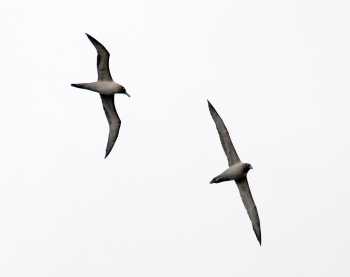Ben Raymond (Australian Antarctic Division, Channel Highway, Tasmania, Australia) and colleagues write in the journal Ecography on tracking electronically ACAP-listed Light-mantled Sooty Albatrosses Phoebetria palpebrata, penguins and seals off East Antarctica.
The paper’s abstract follows:
“Satellite telemetry data are a key source of animal distribution information for marine ecosystem management and conservation activities. We used two decades of telemetry data from the East Antarctic sector of the Southern Ocean. Habitat utilization models for the spring/summer period were developed for six highly abundant, wide-ranging meso- and top-predator species: Adélie Pygoscelis adeliae and emperor Aptenodytes forsteri penguins, light-mantled albatross Phoebetria palpebrata, Antarctic fur seals Arctocephalus gazella, southern elephant seals Mirounga leonina, and Weddell seals Leptonychotes weddellii. The regional predictions from these models were combined to identify areas utilized by multiple species, and therefore likely to be of particular ecological significance. These areas were distributed across the longitudinal breadth of the East Antarctic sector, and were characterized by proximity to breeding colonies, both on the Antarctic continent and on subantarctic islands to the north, and by sea-ice dynamics, particularly locations of winter polynyas. These areas of important habitat were also congruent with many of the areas reported to be showing the strongest regional trends in sea ice seasonality. The results emphasize the importance of on-shore and sea-ice processes to Antarctic marine ecosystems. Our study provides ocean-basin-scale predictions of predator habitat utilization, an assessment of contemporary habitat use against which future changes can be assessed, and is of direct relevance to current conservation planning and spatial management efforts.”

Light-mantled Sooty Albatrosses fly over Antarctic waters, photograph by John Chardine
See a separate report on the publication here.
Reference:
Raymond, B., Lea, Patterson, T., Andrews-Goff, V., Sharples, R., Charrassin, J-B., Cottin, M., Emmerson, L., Gales, N., Gales, R., Goldsworthy, S.D., Harcourt, R., Kato, A., Kirkwood, R., Lawton, K., Ropert-Coudert, Y. Southwell, C., van den Hoff, J., Wienecke, B., Woehler, E.J., Wotherspoon, S. & Hindell, M.A. 2014. Important marine habitat off east Antarctica revealed by two decades of multi-species predator tracking. Ecography DOI:10.1111/ecog.01021.
John Cooper, ACAP Information Officer, 18 July 2014

 English
English  Français
Français  Español
Español